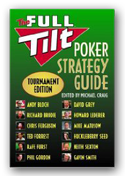 I might as well disclose up front that I am not very good at or knowledgeable about fixed limit hold ’em. In some ways, that makes me unqualified to review a text on the subject, but it also plants me squarely within the target audience of Howard Lederer’s contribution to the Full Tilt Poker Strategy Guide: Tournament Edition. Reading Lederer’s chapter left me with a strong sense, not only of how to handle the individual, nuts-and-bolts decisions of the game but also how to integrate those decisions into a coherent, profitable strategy.
I might as well disclose up front that I am not very good at or knowledgeable about fixed limit hold ’em. In some ways, that makes me unqualified to review a text on the subject, but it also plants me squarely within the target audience of Howard Lederer’s contribution to the Full Tilt Poker Strategy Guide: Tournament Edition. Reading Lederer’s chapter left me with a strong sense, not only of how to handle the individual, nuts-and-bolts decisions of the game but also how to integrate those decisions into a coherent, profitable strategy.
When feeling my way around a new game, I like to know where a winning player’s edge comes from, what situations he seeks to create. I am trying to figure out what I will need to do well, what concepts I will need to master in order to win. Oddly, it takes a while for Lederer to answer this question, and he doesn’t do in the section called, “The Starting Framework for Limit Hold ‘Em Tournament Play”. Eventually, however, he does tell me very clearly what I’ve been waiting to hear: “It’s not about winning pots. It’s about winning bets in limit hold ’em. Being in position… is where you earn your bets.”
Although it isn’t articulated clearly until the middle of the chapter, this is clearly the organizing principle of the strategy Lederer outlines. Street-by-street, he explains both how to take advantage of position when you have it and how to minimize your opponents’ ability to profit from their position. His advice ranges from the very specific, in the form of charts for which hands to play from which position with which action in front of you, to the very general, in the form of an overarching strategy that will keep your opponents guessing, prevent them from taking free cards when they want them, and enable you to get free cards when you need them.
As strong as Lederer’s chapter is as an introduction to the fundamentals of Fixed Limit Hold ‘Em, it is a bit lacking in tournament-specific advice given the context in which it is published. One can infer from his introduction that he believes tight aggressive play to be even more important in a tournament format, where all players are working with a limited number of bets. He warns that, “If you build a loose image, it undercuts your ability to steal.”
The fundamental idea, never articulated as clearly as it could be, seems to be that in tournament Fixed Limit Hold ‘Em, you need to be able to do a lot with a little. As he puts it, “The beauty of my strategy is that you don’t need a big stack to execute it. If you have enough chips to comfortably bet through the hand, that is enough for it to work.” The cut-off, in other words, is four big bets, equivalent to a pre-flop raise, a flop raise, a turn bet, and a river bet.
This makes a lot of sense, since below this critical stack size, you will not have all of your tools at your disposal and probably will not be able to generate the fold equity you need to stay alive. It would have been nice to see more advice about how to maintain this minimum workable stack size. Should I tighten my pre-flop raising standards when I have a six bet stack? Bluff the flop less often? Be more inclined to fold my blinds?
Similarly, should I target the blinds of players hovering just above this critical stack size, on the assumption that they will be playing tighter than usual? Although Lederer suggests that a check-raise bluff on a dry Ace-high flop might have more fold equity in a shallow tournament setting than in a ring game, he never integrates this very specific suggestion into a larger strategy, something that does so well elsewhere in the chapter.
To his credit, he does address other aspects of tournament play, such as adapting to the bubble, adapting to the payout structure of the final table, playing short-handed, and playing short stacked. But ultimately, the tournament advice feels less coherent than the rest of the otherwise very enlightening article.
Howard Lederer’s “Limit Hold ‘Em” chapter is a very helpful introduction to a complex game. He argues that players of no limit hold ’em have a lot to gain from learning this game, and I would add that they have a lot to gain from reading this chapter. Players already confident in their Fixed Limit Hold ‘Em game and looking for advice about adapting to a tournament format would do well to look elsewhere, though. David Sklansky’s Tournament Poker for Advanced Players remains the best resource for them.
